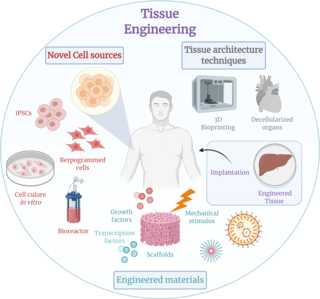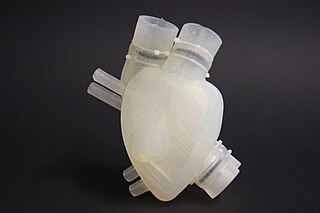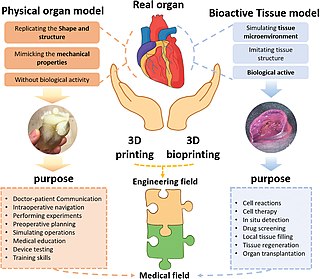An artificial organ is a human made organ device or tissue that is implanted or integrated into a human — interfacing with living tissue — to replace a natural organ, to duplicate or augment a specific function or functions so the patient may return to a normal life as soon as possible. The replaced function does not have to be related to life support, but it often is. For example, replacement bones and joints, such as those found in hip replacements, could also be considered artificial organs.

Tissue engineering is a biomedical engineering discipline that uses a combination of cells, engineering, materials methods, and suitable biochemical and physicochemical factors to restore, maintain, improve, or replace different types of biological tissues. Tissue engineering often involves the use of cells placed on tissue scaffolds in the formation of new viable tissue for a medical purpose but is not limited to applications involving cells and tissue scaffolds. While it was once categorized as a sub-field of biomaterials, having grown in scope and importance it can be considered as a field of its own.
Organ culture is the cultivation of either whole organs or parts of organs in vitro. It is a development from tissue culture methods of research, as the use of the actual in vitro organ itself allows for more accurate modelling of the functions of an organ in various states and conditions.
A biopharmaceutical, also known as a biological medical product, or biologic, is any pharmaceutical drug product manufactured in, extracted from, or semisynthesized from biological sources. Different from totally synthesized pharmaceuticals, they include vaccines, whole blood, blood components, allergenics, somatic cells, gene therapies, tissues, recombinant therapeutic protein, and living medicines used in cell therapy. Biologics can be composed of sugars, proteins, nucleic acids, or complex combinations of these substances, or may be living cells or tissues. They are isolated from living sources—human, animal, plant, fungal, or microbial. They can be used in both human and animal medicine.

Organ printing utilizes techniques similar to conventional 3D printing where a computer model is fed into a printer that lays down successive layers of plastics or wax until a 3D object is produced. In the case of organ printing, the material being used by the printer is a biocompatible plastic. The biocompatible plastic forms a scaffold that acts as the skeleton for the organ that is being printed. As the plastic is being laid down, it is also seeded with human cells from the patient's organ that is being printed for. After printing, the organ is transferred to an incubation chamber to give the cells time to grow. After a sufficient amount of time, the organ is implanted into the patient.

Anthony Atala is an American bioengineer, urologist, and pediatric surgeon. He is the W.H. Boyce professor of urology, the founding director of the Wake Forest Institute for Regenerative Medicine, and the chair of the Department of Urology at Wake Forest School of Medicine in North Carolina. His work focuses on the science of regenerative medicine: "a practice that aims to refurbish diseased or damaged tissue using the body's own healthy cells".

The Methuselah Foundation is an American-based global non-profit organization based in Springfield, Virginia, with a declared mission to "make 90 the new 50 by 2030" by supporting tissue engineering and regenerative medicine therapies. The organization was originally incorporated by David Gobel in 2001 as the Performance Prize Society, a name inspired by the British governments Longitude Act, which offered monetary rewards for anyone who could devise a portable, practical solution for determining a ship's longitude.

David Gobel is an American philanthropist, entrepreneur, inventor, and futurist. He is co-founder and CEO of the Methuselah Foundation, CEO of the Methuselah Fund, and one of the first to publicly advance the idea of longevity escape velocity, even before this term was formulated.
NovoGen is a proprietary form of 3D printing technology that allows scientists to assemble living tissue cells into a desired pattern. When combined with an extracellular matrix, the cells can be arranged into complex structures, such as organs. Designed by Organovo, the NovoGen technology has been successfully integrated by Invetech with a production printer that is intended to help develop processes for tissue repair and organ development.

United Therapeutics Corporation is an American publicly traded biotechnology company and public benefit corporation listed on the NASDAQ under the symbol UTHR. It develops novel, life-extending technologies for patients in the areas of lung disease and organ manufacturing. United Therapeutics is co-headquartered in Silver Spring, Maryland and Research Triangle Park, North Carolina, with additional facilities in Magog and Bromont, Quebec; Melbourne and Jacksonville, Florida; Blacksburg, Virginia; and Manchester, New Hampshire.

Three dimensional (3D) bioprinting is the utilization of 3D printing–like techniques to combine cells, growth factors, and/or biomaterials to fabricate biomedical parts, often with the aim of imitating natural tissue characteristics. Generally, 3D bioprinting can utilize a layer-by-layer method to deposit materials known as bio-inks to create tissue-like structures that are later used in various medical and tissue engineering fields. 3D bioprinting covers a broad range of bioprinting techniques and biomaterials. Currently, bioprinting can be used to print tissue and organ models to help research drugs and potential treatments. Nonetheless, translation of bioprinted living cellular constructs into clinical application is met with several issues due to the complexity and cell number needed to create functional organs. However, innovations span from bioprinting of extracellular matrix to mixing cells with hydrogels deposited layer by layer to produce the desired tissue. In addition, 3D bioprinting has begun to incorporate the printing of scaffolds which can be used to regenerate joints and ligaments.
Magnetic 3D bioprinting is a methodology that employs biocompatible magnetic nanoparticles to print cells into 3D structures or 3D cell cultures. In this process, cells are tagged with magnetic nanoparticles (nanoshuttle) that are used to render them magnetic. Once magnetic, these cells can be rapidly printed into specific 3D patterns using external magnetic forces that mimic tissue structure and function.

Fujifilm Cellular Dynamics, Inc. (FCDI) is a large scale manufacturer of human cells, created from induced pluripotent stem cells, for use in basic research, drug discovery and regenerative medicine applications.
Regeneration in humans is the regrowth of lost tissues or organs in response to injury. This is in contrast to wound healing, or partial regeneration, which involves closing up the injury site with some gradation of scar tissue. Some tissues such as skin, the vas deferens, and large organs including the liver can regrow quite readily, while others have been thought to have little or no capacity for regeneration following an injury.
Ethics of bioprinting is a sub-field of ethics concerning bioprinting. Some of the ethical issues surrounding bioprinting include equal access to treatment, clinical safety complications, and the enhancement of human body.
Bico Group is a bioconvergence startup that designs and supplies technologies and services to enhance biology research. It focuses on commercializing technologies for life science research as well as bioprinting, and its products often combine capabilities in artificial intelligence, robotics, multiomics, and diagnostics.

Microgravity bioprinting is the utilization of 3D bioprinting techniques under microgravity conditions to fabricate highly complex, functional tissue and organ structures. The zero gravity environment circumvents some of the current limitations of bioprinting on Earth including magnetic field disruption and biostructure retention during the printing process. Microgravity bioprinting is one of the initial steps to advancing in space exploration and colonization while furthering the possibilities of regenerative medicine.
The Wyss Institute for Biologically Inspired Engineering is a cross-disciplinary research institute at Harvard University focused on bridging the gap between academia and industry by drawing inspiration from nature's design principles to solve challenges in health care and the environment. It is focused on the field of biologically inspired engineering to be distinct from bioengineering and biomedical engineering. The institute also has a focus on applications, intellectual property generation, and commercialization. The Wyss Institute is located in Boston's Longwood Medical Area and has 375 full-time staff. The Wyss is organized around eight focus areas, each of which integrate faculty, postdocs, fellows, and staff scientists. The focus areas are bioinspired therapeutics & diagnostics, diagnostics accelerator, immuno-materials, living cellular devices, molecular robotics, 3D organ engineering, predictive bioanalytics and synthetic biology.
Biofabrication is a branch of biotechnology specialising in the research and development of biologically engineered processes for the automated production of biologically functional products through bioprinting or bioassembly and subsequent tissue maturation processes; as well as techniques such as directed assembly, which employs localised external stimuli guide the fabrification process; enzymatic assembly, which utilises selective biocatalysts to build macromolecular structures; and self-assembly, in which the biological material guides its own assembly according to its internal information. These processes may facilitate fabrication at the micro- and nanoscales. Biofabricated products are constructed and structurally organised with a range of biological materials including bioactive molecules, biomaterials, living cells, cell aggregates such as micro-tissues and micro-organs on chips, and hybrid cell-material constructs.
Bioprinting drug delivery is a method of using the three-dimensional printing of biomaterials through an additive manufacturing technique to develop drug delivery vehicles that are biocompatible tissue-specific hydrogels or implantable devices. 3D bioprinting uses printed cells and biological molecules to manufacture tissues, organs, or biological materials in a scaffold-free manner that mimics living human tissue to provide localized and tissue-specific drug delivery, allowing for targeted disease treatments with scalable and complex geometry.








